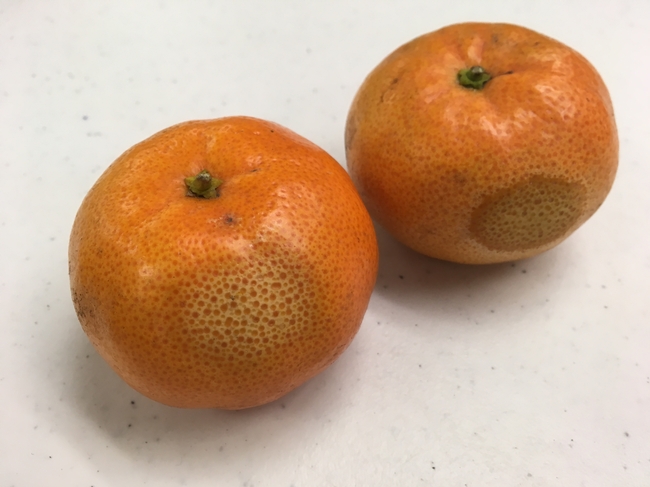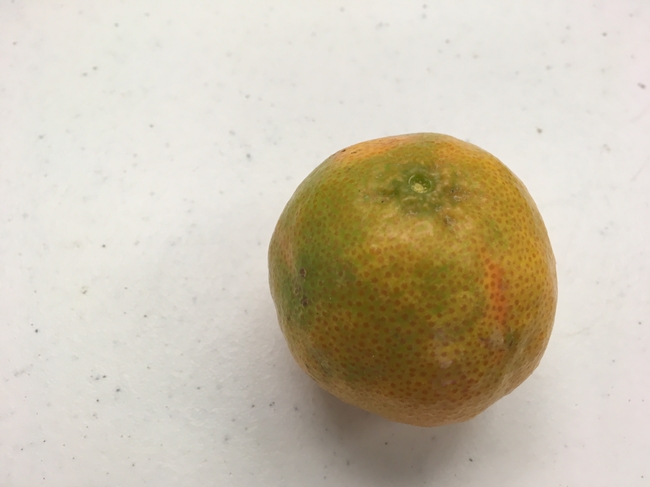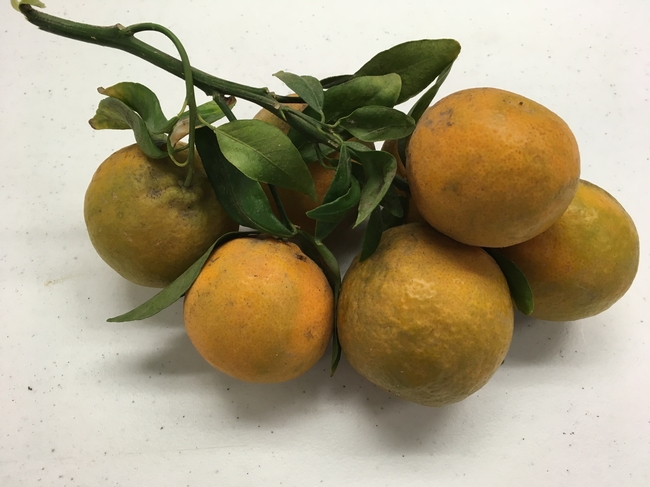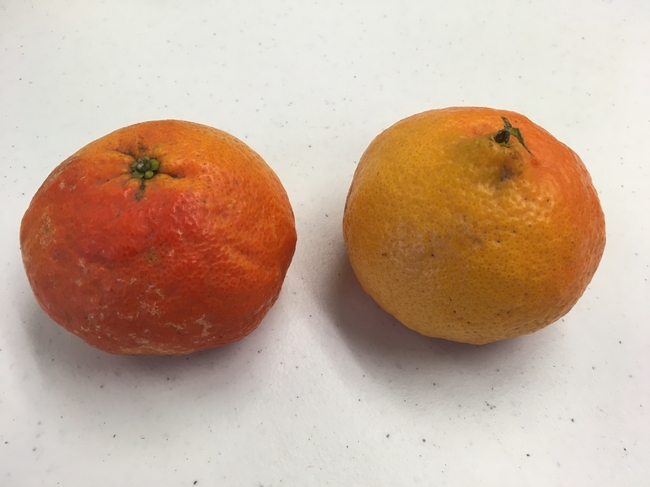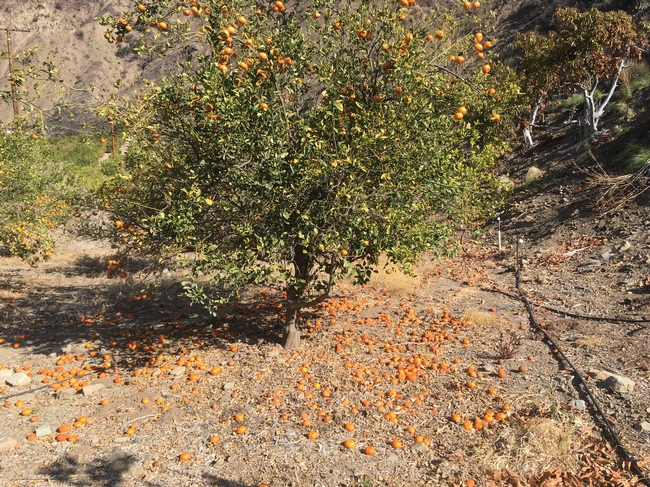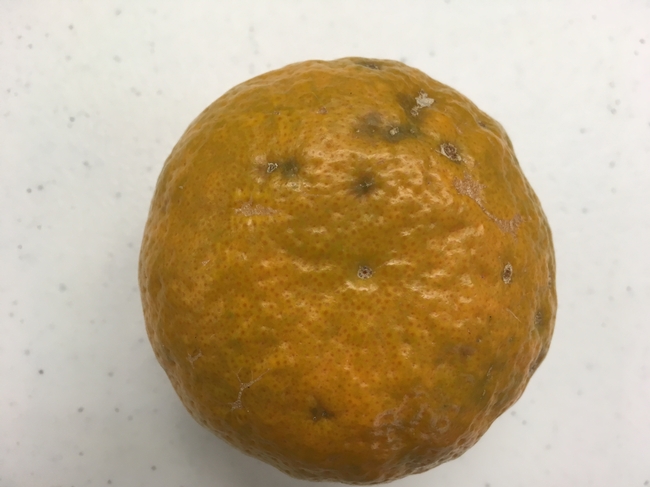
Posts Tagged: postharvest
Hot Mandarins. What to Look forward to After a Fire
Mandarins, also known as “zipper skins” and “easy peelers” can have very fragile peels/skins/rinds/exocarp that make them easily subject to more damage than most oranges and lemons. Some are a bit tougher skinned than others, but some are so fragile that any rough handling often prevents them from going through conventional packing operations.
These skins were recently put to the test in the recent fires in Ojai. There was a mix of different varieties - ‘Pixie', ‘Gold Nugget', ‘W. Murcott', ‘Yosemite Gold', ‘Tahoe Gold' and others. Some of them were more sensitive than others, some were closer to the fire, all were affected by smoke to some degree. In Matilija Canyon where smoke was present for many more days than in the east of the Ojai Valley and possibly more ash, the trees have started flowering sooner. That might be temperature difference, either cooler or warmer, so it is hard to say how much effect the smoke has had versus, the ash and/or heat. Smoke has many different gasses in it, one of which is ethylene which is a naturally occurring ripening agent. Smoke not only has gasses, but it occludes the sun so less or more or altered light might have an effect on these fruit. It's not a controlled experiment, so some little scientist is going to have to come along and wriggle out these different effects. Whatever. Fire and smoke have an effect on mandarins as we have seen in other crops, such as cherimoya, avocados and other citrus.
Heat damage. Fruit facing the fire.
Ash effects on fruit coloring. Fruit was covered with ash for several days until rain washed it off. Might be a pH effect (ash is alkaline), temperature effect, uneven light radiation, or other…….
Same sort of uneven coloring, that actually looks like an ashy color, but the ash has washed off the cluster by rain
And here's something interesting where fruit facing the fire is much lighter colored than fruit facing away from the fire. Here are two pieces of fruit, one from the side directly facing the fire, and the other from the other side of the tree. The side of that fruit facing the fire was also lighter colored. So, it had an effect through the canopy (small tree). The canopy was otherwise intact, unaffected heat or flames.
Oh yeah, and there is the characteristic fruit drop from either the heat, smoke gases, water stress or ….
And then there's the fruit that looks like it had actual embers on the skin.
If the tree survives and keeps its green leaves, sometimes the fruit is affected in ways that don't appear for a while. The peel may be affected, but in many cases the fruit is just as sweet as it could be. It just looks terrible. That might even be a selling point. "Here have a wonderous piece of history that braved the horror of the Ojai fires."
Red Discoloration in My Avocado Flesh
The questions that come in stump many of us, but we often have ways of finding answers. Here's a recent request and Mary Lu Arpaia's response. She's one of our Postharvest Physiologist Specialists.
The Question:
"I am an extension specialist in NH, and I work with (mostly temperate!) fruit/veg crops. A consumer has reached out to the NH Division of Public Health here, with concerns about an avocado they purchased. I'm reaching out to you because you have written some outreach materials relating to avocado, and I suspect that you are much more familiar with this crop than we in New Hampshire are.
Would you have any insights about red discoloration inside an avocado fruit (see attached photo)? It does not look like typical chilling injury to me. Any thoughts would be welcome. Thank you for your time!"
Mary Lu's Response:
"You occasionally see this problem in ripe fruit, especially in lower maturity fruit.
Anyway the best guess is that it is phenolics from the seed coat leaking into the flesh of the fruit.
Not dangerous but the affected flesh may be bitter. I would cut it out and eat around the discolored flesh which is surface only."
Consumers in far away places often will see problems that we in avocado growing regions may never see. Increasingly though, the fruit is grown not so close to home and has traveled long distances, been handled by many different people and treated in less than acceptable fashion. So we may see more fruit problems in California as we import more fruit.

avocado red staining
Rindstain in 'Valencia' Orange
Arpaia M.L.; Kahn T.L.; El Otmani M.; Coggins C.W.Jr; Demason D.A.; O'connell N.V.; Pehrson J.E.Jr, 1991: Pre harvest rind stain of valencia orange histochemical and developmental characterization. Scientia Horticulturae (amsterdam). 46(3-4): 261-274
Pre-harvest rindstain of California [USA] cultivar 'Valencia' orange Citrus sinensis has economic significance since fresh fruit marketability is reduced. Quantification of the incidence of rindstain as related to tree quadrant has allowed us to designate quadrants where rindstain was most likely to occur (upper outside SW) or least likely (lower inside NE) to occur. Growth and development characteristics of fruit from the two quadrants were measured throughout fruit development. Significant differences in percent weight loss between fruit from the SW and NE quadrants occurred at color break and at commercial maturity. Structural and histochemical changes in flavedo tissue of fruit from SW or NE tree quadrants were monitored over the course of fruit development and maturation. First evidence of periderm formation occurred in October, coincident with observed changes in histochemical staining for lipids. These differences were increasingly evident as the fruit approached horticultural maturity and visual symptoms of rindstain developed. The development of a pronounced periderm in affected fruit suggests that rindstain is due to a physical trauma, although we do not believe it is caused by wind.
This from Mary Lu Arpaia in response from a Central Valley problem that cropped up recently. Fruit looked on the tree, but after getting it into the packing house, it started showing these symptoms
Here is her summation of the abstract above:
1) Fruit were predisposed to this problem as early as colorbreak. We found this out by doing some elaborate fruit manipulations in the field in the fall and looking at symptoms in the spring.
2) Symptoms really started to appear about this time of year and then progressively worse
3) There was a loose correlation to presence of citrus thrips in the previous year
4) Fruit isolations did not find much of anything but weak saprophytic fungi.
5) At this point, it's not clear what a grower can do to prevent it.
Rindstain on Ruby Red Grapefruit in the Hemet area was noted in the 1990's and the observation there was possible moisture from dew or rain focusing sunlight to cause the condition. So it's not really from even a general observation.

valencia rind stain 2

valencia rind stain3

